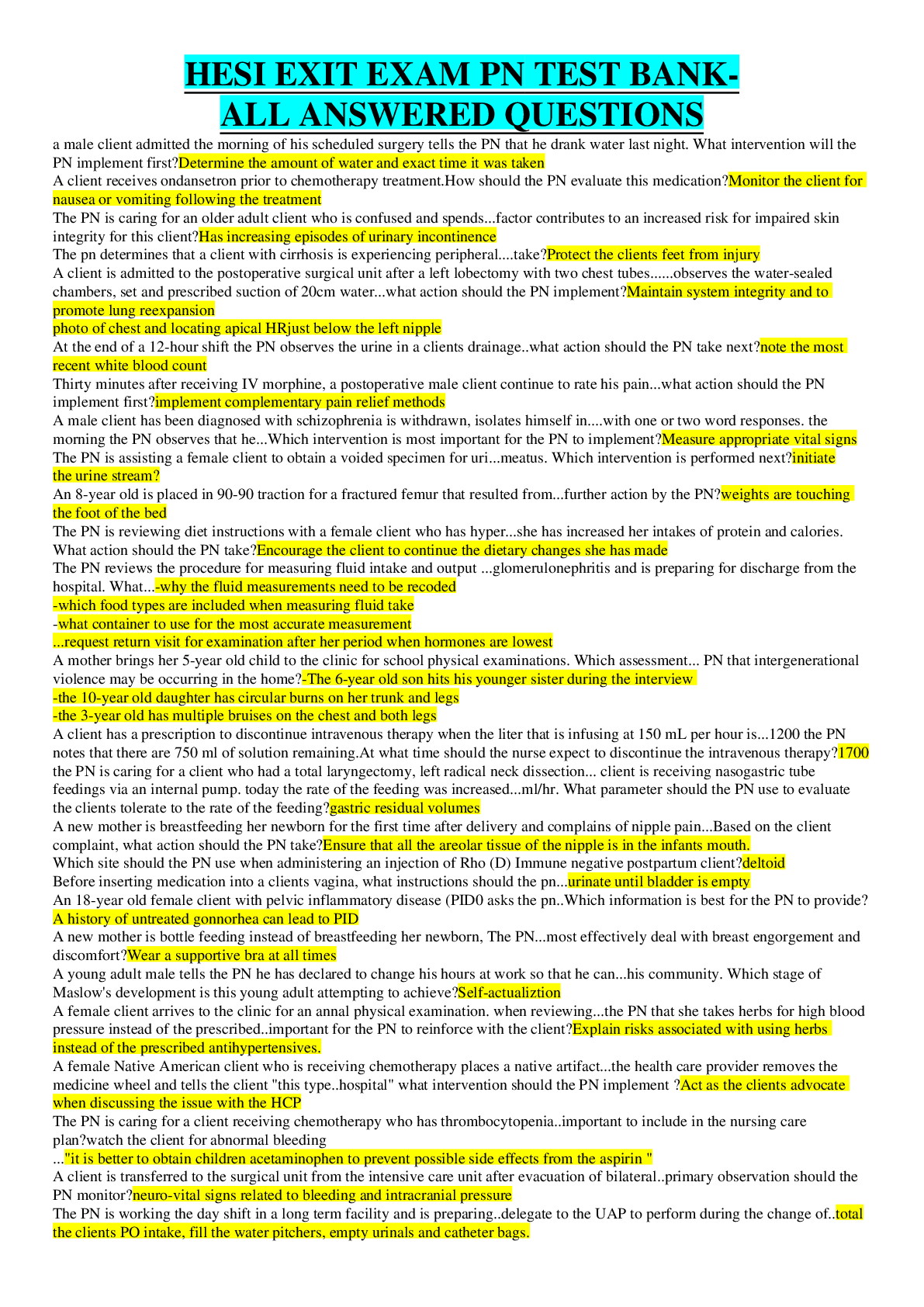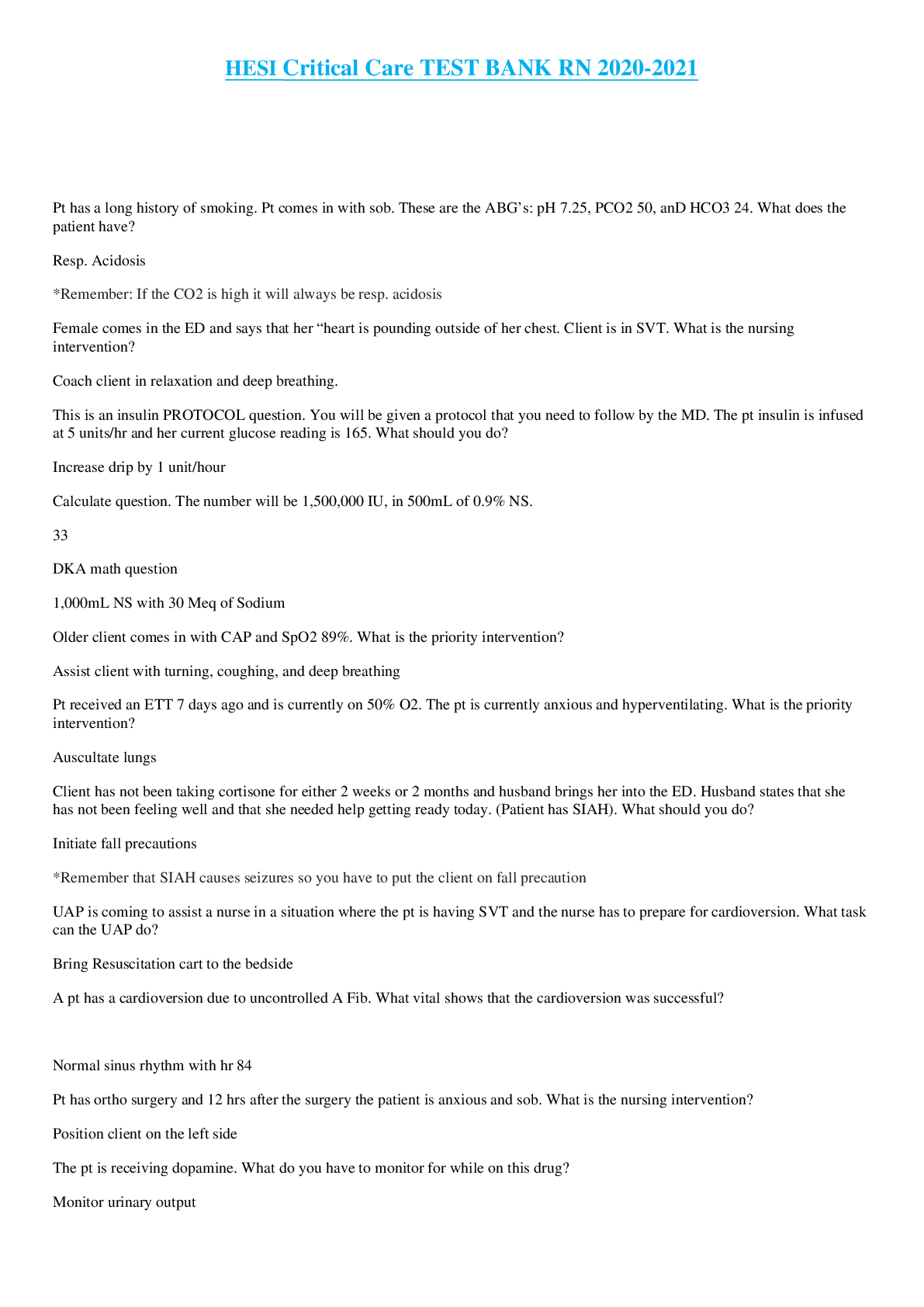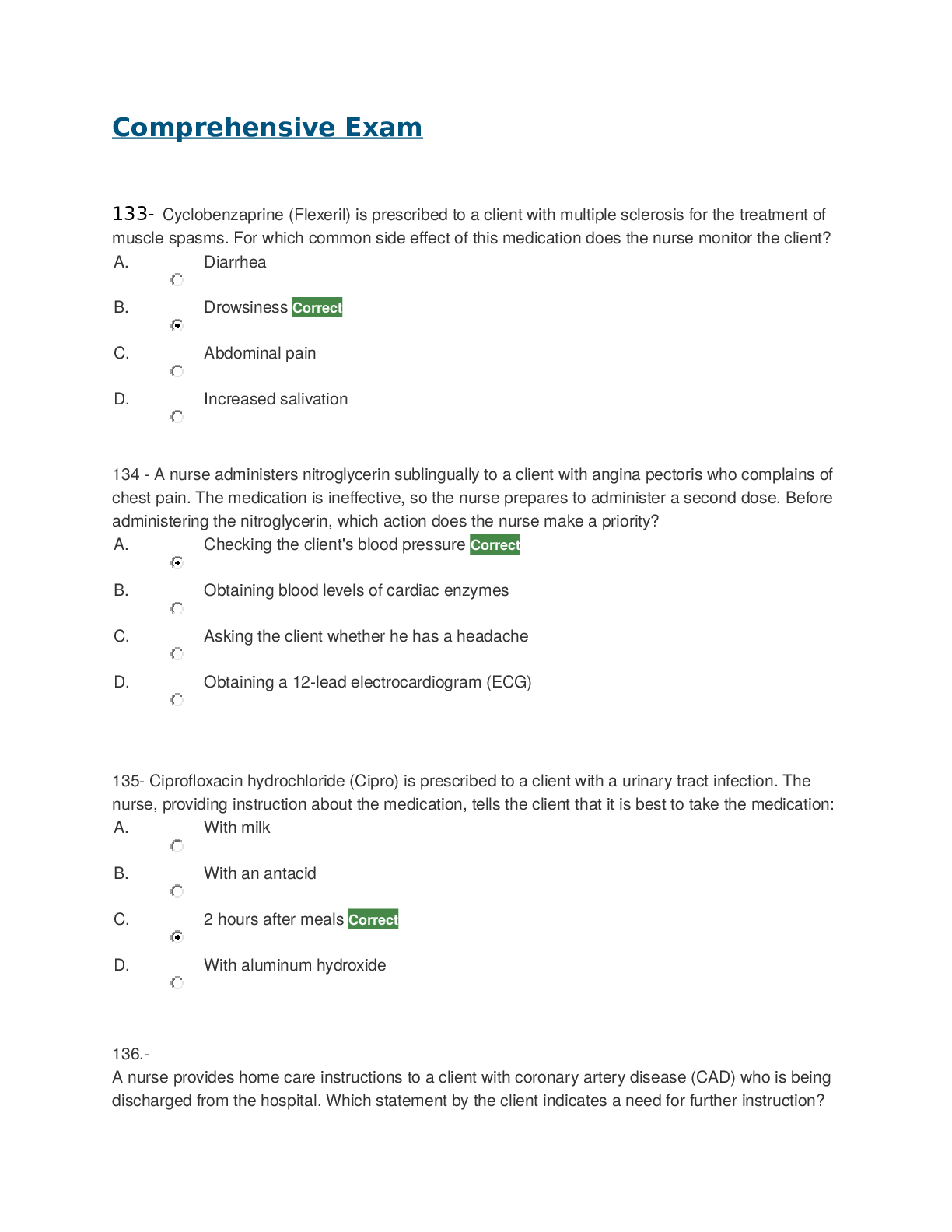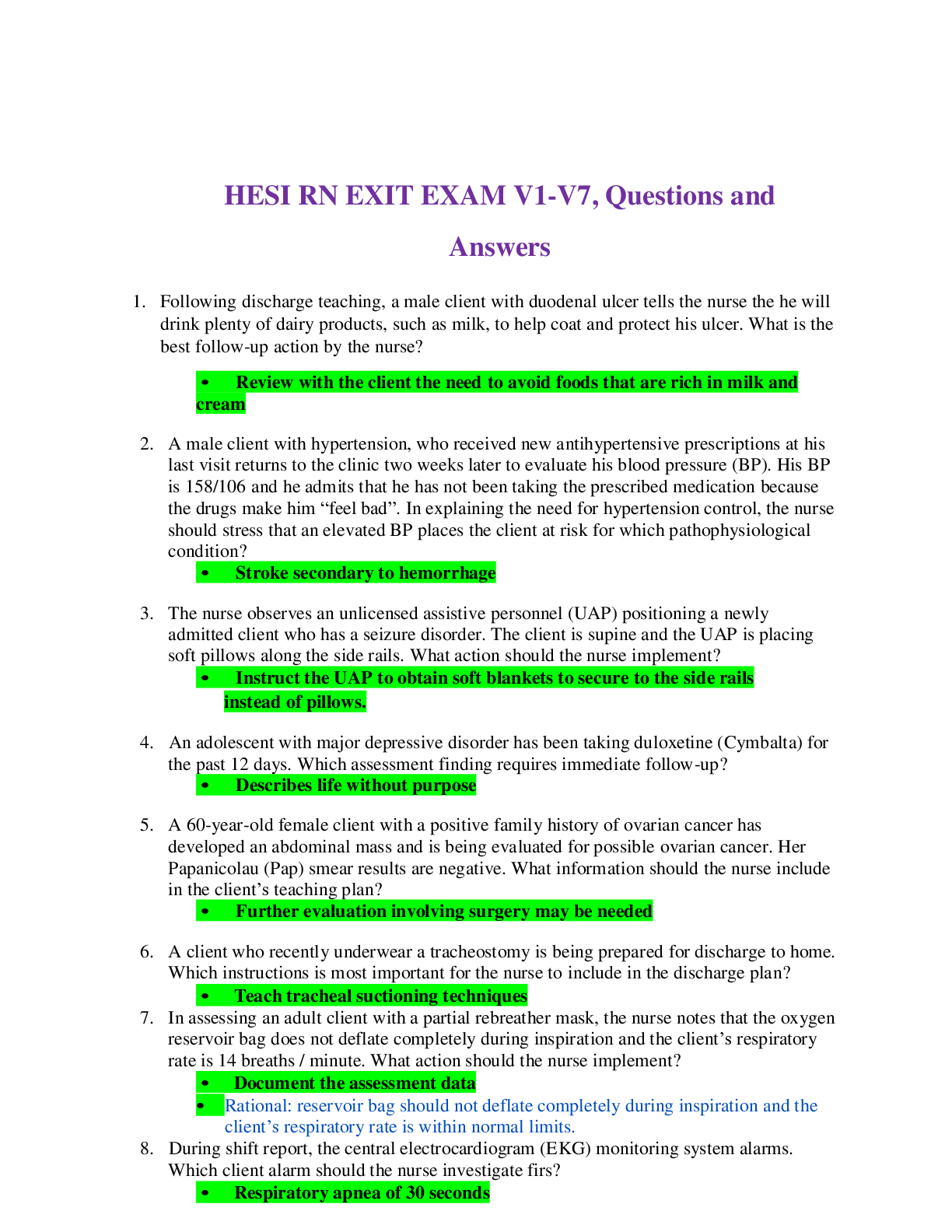*NURSING > HESI > PEDIATRIC PN HESI Speciality Exam(55 Quality Questions & Answers) (NEW-2021/2022, All Correct Answer (All)
PEDIATRIC PN HESI Speciality Exam(55 Quality Questions & Answers) (NEW-2021/2022, All Correct Answers)
Document Content and Description Below
PEDIATRIC PN HESI Speciality Exam 1) A toddler is receiving an infusion of total parenteral nutrition via a Broviac catheter. As the child plays, the I.V. tubing becomes disconnected from the cathete... r. What should the LPN/LVN do first? a. Turn off the infusion pump. b. Position the child on the side. c. Clamp the catheter. d. Flush the catheter with heparin. Correct Answer: C. Clamp the catheter. 2) A LPN/LVN is conducting an infant nutrition class for parents. Which foods are appropriate to introduce during the first year of life? Select all that apply. a. Sliced beef b. Pureed fruits c. Whole milk d. Rice cereal e. Strained vegetables f. Fruit juice Correct Answer: b. Pureed fruits d. Rice cereal e. Strained vegetables 3) A mother tells the nurse that her preschool-age daughter with spina bifida sneezes and gets a rash when playing with brightly colored balloons, and that recently she had an allergic reaction after eating kiwifruit and bananas. The LPN/LVN would suspect that the child may have an allergy to: a. bananas. b. latex. c. kiwifruit. d. color dyes. Correct Answer: B. latex. 4) A LPN/LVN is developing a plan to teach a mother how to reduce her infant's risk of developing otitis media. Which direction should the nurse include in the teaching plan? a. Administer antibiotics whenever the infant has a cold. b. Place the infant in an upright position when giving a bottle. c. Avoid getting the infant's ears wet while bathing or swimming. d. Clean the infant's external ear canal daily. Correct Answer: B. Place the infant in an upright position when giving a bottle. 5) When developing a care plan for an adolescent, the nurse considers the child's psychosocial needs. During adolescence, psychosocial development focuses on: a. becoming industrious. b. establishing an identity. c. achieving intimacy. d. developing initiative. Correct Answer: B. establishing an identity. 6) A LPN/LVN is planning care for a 10-year-old child in the acute phase of rheumatic fever. Which activity is most appropriate for the nurse to schedule in the care plan? a. Playing ping-pong b. Reading books c. Climbing on play equipment in the playroom d. Ambulating without restrictions Correct Answer: B. Reading books 7) A LPN/LVN is assessing a severely depressed adolescent. Which finding indicates a risk of suicide? a. Excessive talking b. Excessive sleepiness c. A history of cocaine use d. A preoccupation with death Correct Answer: D. A preoccupation with death 8) A child is admitted with a tentative diagnosis of clinical depression. Which assessment finding is most significant in confirming this diagnosis? a. Irritability b. Sadness c. Weight gain d. Fatigue Correct Answer: B. Sadness 9) A child with iron deficiency anemia is ordered ferrous sulfate (Ferralyn), an oral iron supplement. When teaching the child and parent how to administer this preparation, the mother asks why she needs to mix the supplement with citrus juice. Which response by the nurse is best? a. "The vitamin C in the citrus juice helps with iron absorption." b. "Having food and juice in the stomach helps with iron absorption." c. "The citrus juice counteracts the unpleasant taste of the iron." d. "There isn't a specific reason for it." Correct Answer: A. "The vitamin C in the citrus juice helps with iron absorption." 10) When assessing a child for impetigo, the nurse expects which assessment findings? a. Small, brown, benign lesions b. Honey-colored, crusted lesions c. Linear, threadlike burrows d. Circular lesions that clear centrally Correct Answer: B. Honey-colored, crusted lesions 11) A female adolescent client refuses to allow male nurses to care for her while she's hospitalized. Which of these health care rights is this adolescent exerting? a. Right to competent care b. Right to have an advance directive on file c. Right to confidentiality of her medical record d. Right to privacy 12) A LPN/LVN is reviewing a teaching plan with parents of an infant undergoing repair for a cleft lip. Which instructions are the most appropriate for the nurse to give? Select all that apply. a. Offer a pacifier as needed. b. Lay the infant on his back or side to sleep. c. Sit the infant up for each feeding. d. Loosen the arm restraints every 4 hours. e. Clean the suture line after each feeding by dabbing it with saline solution. f. Give the infant extra care and support. 13) A LPN/LVN notes that an infant develops arm movement before fine- motor finger skills and interprets this as an example of which pattern of development? a. Cephalocaudal b. Proximodistal c. Differentiation d. Mass-to-specific 14) A teenage mother brings her 1-year-old child to the pediatrician's office for a well-baby checkup. She says that her infant can't sit alone or roll over. An appropriate response by the nurse would be: a. "This is very abnormal. Your child must be sick." b. "Let's see about further developmental testing." c. "Don't worry, this is normal for her age." d. "Maybe you just haven't seen her do it." 15) Which finding in a 3-year-old child with acute renal failure requires immediate follow-up? a. Potassium level of 6.5 mEq/L b. Blood pressure in right leg of 90/50 mm Hg c. Abdominal cramps d. No albumin in the urine 16) A school nurse is evaluating a 7-year-old child who is having an asthma attack. The child is cyanotic and unable to speak, with decreased breath sounds and shallow respirations. Based on these physical findings, the nurse should first: a. monitor the child with a pulse oximeter in her office. b. prepare to ventilate the child. c. return the child to class. d. contact the child's parent or guardian. 17) The mother of an 11-month-old infant reports to the nurse that her infant sleeps much less than other children. The mother asks the nurse whether her infant is getting sufficient sleep. What should be the nurse's initial response? a. Reassure the mother that each infant's sleep needs are individual. b. Ask the mother for more information about the infant's sleep patterns. c. Instruct the mother to decrease the infant's daytime sleep to increase his nighttime sleep. d. Inform the mother that her infant's growth and development are appropriate for his age, so sleep isn't a concern. 18) Which item in the care plan for a toddler with a seizure disorder should a nurse revise? a. Padded side rails b. Oxygen mask and bag system at bedside c. Arm restraints while asleep d. Cardiorespiratory monitoring 19) A LPN/LVN observes a 2½-year-old child playing with another child of the same age in the playroom on the pediatric unit. What type of play should the nurse expect the children to engage in? a. Associative play b. Parallel play c. Cooperative play d. Therapeutic play 20) A 14-year-old adolescent with type 1 diabetes checks his blood glucose level at 9:00 p.m. before going to bed. It has been 4 hours since his dinner and his regular insulin dose. His blood glucose level is 60 mg/dl, and he states that he feels a little shaky. What should the nurse suggest? a. A bedtime snack of an 8-oz glass of milk and graham crackers with peanut butter b. Going to sleep to decrease the metabolic demands on the body c. Taking a dose of glucagon d. Doing nothing because the glucose level is unreliable because the adolescent measured it himself 21) A 13-year-old girl is being evaluated for possible Crohn's disease. The nurse expects to prepare her for which diagnostic study? a. Genetic testing b. Cystoscopy c. Myelography d. Colonoscopy with biopsy 22) An infant who weighs 7.5 kg is to receive ampicillin (Omnipen) 25 mg/kg I.V. every 6 hours. How many milligrams should the nurse administer per dose? Record your answer using one decimal place. 23) A 4-year-old has just returned from surgery. He has a nasogastric (NG) tube in place and is attached to intermittent suction. The child says to the nurse, "I'm going to throw up." What should the nurse do first? a. Notify the physician because the child has an NG tube. b. Immediately give the child an antiemetic I.V. c. Irrigate the NG tube to ensure patency. d. Encourage the mother to calm the child down. 24) A child, age 5, is diagnosed with chronic renal failure. When teaching the parents about diet therapy, the nurse should instruct them to restrict which foods from the child's diet? a. Meats b. Carbohydrates c. Fats d. Dairy products 25) An 8-year-old child is suspected of having meningitis. Signs of meningitis include: a. Cullen's sign. b. Koplik's spots. c. Kernig's sign. d. Chvostek's sign. 26) A 6-year-old child is admitted to the pediatric unit for evaluation of recurrent abdominal pain. The child has been admitted to the pediatric unit with similar complaints several times in the past few months. The child's symptoms are vague, yet his mother provides detailed information about the problem. The nurse is suspicious of the situation. What should the LPN/LVN do next? a. Request that the parent leave the hospital unit immediately. b. Ask to speak with the child without the parent being present. c. Notify the physician and request assistance from the interdisciplinary team. d. Contact the authorities immediately. 27) When making ethical decisions about caring for preschoolers, a nurse should remember to: a. provide beneficial care and avoid harming the child. b. make decisions that will prevent legal trouble. c. do what she would do for her own child or loved ones. d. be sure to do what the physician says. 28) An emergency department nurse suspects neglect in a 3-year-old boy admitted for failure to thrive. Signs of neglect in the child would include: a. slapping, kicking, and punching others. b. poor hygiene and weight loss. c. loud crying and screaming. d. pulling hair and hitting. 29) When administering gentamicin (Garamicin) to a preschooler, which monitoring schedule is best for determining the drug's effectiveness? a. A serum trough level every morning b. A serum peak level after the second dose c. A serum trough and peak level around the third dose d. Serial serum trough levels after three doses (24 hours) 30) Which intervention provides the most accurate information about an infant's hydration status? a. Monitoring the infant's vital signs b. Accurately measuring intake and output c. Monitoring serum electrolyte levels d. Weighing the infant daily 31) When developing a care plan for a child, the nurse identifies which Eriksonian stage as corresponding to Freud's oral stage of psychosexual development? a. Initiative versus guilt b. Autonomy versus shame and doubt c. Trust versus mistrust d. Industry versus inferiority 32) An 8-year-old child has just returned from the operating room after having a tonsillectomy. The nurse is preparing to do a postoperative assessment. The nurse should be alert for which signs and symptoms of bleeding? Select all that apply. a. Frequent clearing of the throat b. Breathing through the mouth c. Frequent swallowing d. Sleeping for long intervals e. Pulse rate of 98 beats/minute f. Bright red vomitus 33) A child's physician orders a drug for home use. Before the child is discharged, the nurse should: a. teach the family how to adjust the drug dosage according to the child's needs. b. provide the family with the drug's name, dosage, route, and frequency of administration. c. instruct the family to encourage the child to take responsibility for ensuring timely drug administration. d. tell the family to avoid explaining the purpose of the medication to the child. 34) A child, age 5, has acute lymphocytic leukemia (ALL) and is receiving induction chemotherapy consisting of vincristine (Oncovin), asparaginase (L- asparaginase [Elspar]), and prednisone (Deltasone). When teaching the parents about the adverse effects of this regimen, the nurse should stress the importance of promptly reporting: a. hair loss. b. moon face. c. blindness. d. bone pain. 35) A LPN/LVN is providing care to a 5-year-old child with a fractured femur whose nursing diagnosis is Imbalanced nutrition: Less than body requirements. Which change is most likely to occur with this condition? a. Decreased protein catabolism b. Increased calorie intake c. Increased digestive enzymes d. Increased carbohydrate need 36) A LPN/LVN is caring for a 9-year-old child who has a grave prognosis after receiving a closed injury from being struck by a car. Which health team member should approach the family about organ donation? a. Nurse-manager b. Transplant coordinator c. Emergency department nurse d. Pastoral care staff member 37) An 11-year-old child contracted severe acute respiratory syndrome (SARS) when traveling abroad with her parents. The nurse knows she must put on personal protective equipment to protect herself while providing care. Based on the mode of SARS transmission, which personal protective equipment should the LPN/LVN wear? a. Gloves b. Gown and gloves c. Gown, gloves, and mask d. Gown, gloves, mask, and eye goggles or eye shield 38) An 18-month-old boy is admitted to the pediatric unit with a diagnosis of celiac disease. What finding would the LPN/LVN expect in this child? a. A concave abdomen b. Bulges in the groin area c. A protuberant abdomen d. A palpable abdominal mass 39) A boy, age 3, develops a fever and rash and is diagnosed with rubella. His mother has just given birth to a baby girl. Which statement by the mother best indicates that she understands the implications of rubella? a. "I told my husband to give my son aspirin for his fever." b. "I'll ask the physician about giving the baby an immunization shot." c. "I don't have to worry because I've had the measles." d. "I'll call my neighbor who's 2 months pregnant and tell her not to have contact with my son." 40) Intraosseous infusion of a medication would be most appropriate for which child? a. An 18-month-old child with cystic fibrosis b. A 2-year-old child with a ruptured spleen and hypovolemia c. A 4-year-old child with celiac disease d. A 5-year-old child with status asthmaticus 41) An infant, age 10 months, is brought to the well-baby clinic for a follow- up visit. The mother tells the nurse that she has been having trouble feeding her infant solid foods. To help correct this problem, the nurse should: a. point out that tongue thrusting is the infant's way of rejecting food. b. instruct the mother to place the food at the back and toward the side of the infant's mouth. c. advise the mother to puree foods if the child resists them in solid form. d. suggest that the mother force-feed the child if necessary. 42) A 3-month-old infant just had a cleft lip and palette repair. To prevent trauma to the operative site, the nurse should: a. give the infant a pacifier to help soothe him. b. lie the infant in the prone position. c. place the infant's arms in soft elbow restraints. d. avoid touching the suture line, even to clean. 43) A child is suspected of having amblyopia ("lazy eye"). To help diagnose this disorder, the child will undergo which test? a. Snellen's test b. Near vision test c. Weber's test d. Peripheral vision test 44) A 10-year-old child diagnosed with acute glomerulonephritis is admitted to the pediatric unit. The nurse should ensure that which action is a part of the child's care? a. Taking vital signs every 4 hours and obtaining daily weight b. Obtaining a blood sample for electrolyte analysis every morning c. Checking every urine specimen for protein and specific gravity d. Ensuring that the child has accurate intake and output and eats a high- protein diet 45) A 4-month-old infant is taken to the pediatrician by his parents because they're concerned about his frequent respiratory infections, poor feeding habits, frequent vomiting, and colic. The physician notes that the infant has failed to gain expected weight and recommends that the infant have a sweat test performed to detect possible cystic fibrosis. To prepare the parents for the test, the nurse should explain that: a. the baby will need to fast before the test. b. a sample of blood will be necessary. c. a low-sodium diet is necessary for 24 hours before the test. d. a low-intensity, painless electrical current is applied to the skin. 46) An 8-month-old infant is admitted to the pediatric unit following a fall from his high chair. The child is awake, alert, and crying. The nurse should know that a brain injury is more severe in children because of: a. increased myelination. b. intracranial hypotension. c. cerebral hyperemia. d. a slightly thicker cranium. 47) To treat a child's atopic dermatitis, a physician orders a topical application of hydrocortisone cream twice daily. After medication instruction by the LPN/ LVN , which statement by the parent indicates effective teaching? a. "I will spread a thick coat of hydrocortisone cream on the affected area and will wash this area once a week." b. "I will gently scrape the skin before applying the cream to promote absorption." c. "I will avoid using soap and water on the affected area and will apply an emollient cream on this area frequently." d. "I will apply a moisturizing cream sparingly and will wash the affected area frequently." 48) A LPN/LVN is auscultating for heart sounds in a 2-year-old child. She notes a grade 1 heart murmur. Which characteristic best describes a grade 1 heart murmur? a. Equal in loudness to the heart sounds b. Softer than the heart sounds c. Can be heard without a stethoscope d. Associated with a precordial thrill 49) When a LPN/LVN assesses a 2-year-old child with suspected dehydration, which condition should be reported to the physician immediately? a. Irritability for the past 12 hours b. Capillary refill less than 2 seconds c. Decreased blood pressure d. Tachycardia, dry skin, and dry mucous membranes 50) A LPN/LVN is teaching a safety class for parents of preschoolers. Which injuries should the nurse include as common among preschoolers? Select all that apply. a. Automobile accidents b. Drowning c. Pedestrian accidents d. Fire e. Sexually transmitted diseases f. Homicide 51) When planning care for a 7-year-old boy with Down syndrome, the LPN/ LVN should: a. plan interventions at the developmental level of a 7-year-old because that is the child's age. b. plan interventions at the developmental level of a 5-year-old because the child will have developmental delays. c. assess the child's current developmental level and plan care accordingly. d. direct all teaching to the parents because the child can't understand. 52) A LPN/LVN is reviewing a care plan for an infant undergoing phototherapy for hyperbilirubinemia. Which intervention should the nurse remove from the care plan? a. Repositioning the infant frequently to expose all body surfaces b. Obtaining frequent serum bilirubin levels c. Shielding the infant's eyes with an opaque mask to prevent exposure to the light d. Performing frequent visual assessments of jaundice 53) An infant, age 6 weeks, is brought to the clinic for a well-baby visit. To assess the fontanels, how should the LPN/LVN position the infant? a. Supine b. Prone c. In the left lateral position d. Seated upright 54) A 13-year-old with anorexia nervosa is admitted to the facility for I.V. fluid therapy and nutritional management. She says she's worried that the I.V. fluids will make her gain weight. Which nursing diagnosis is most appropriate? a. Noncompliance (dietary regimen) b. Disturbed body image c. Complicated grieving d. Grieving 55) A LPN/LVN is caring for an adolescent who underwent surgery for a perforated appendix. When caring for this adolescent, the nurse should keep in mind that the main life-stage task for an adolescent is to: a. resolve conflict with parents. b. develop an identity and independence. c. develop trust. d. plan for the future. [Show More]
Last updated: 1 year ago
Preview 1 out of 16 pages
Instant download

Instant download
Reviews( 0 )
Document information
Connected school, study & course
About the document
Uploaded On
Apr 09, 2021
Number of pages
16
Written in
Additional information
This document has been written for:
Uploaded
Apr 09, 2021
Downloads
0
Views
330


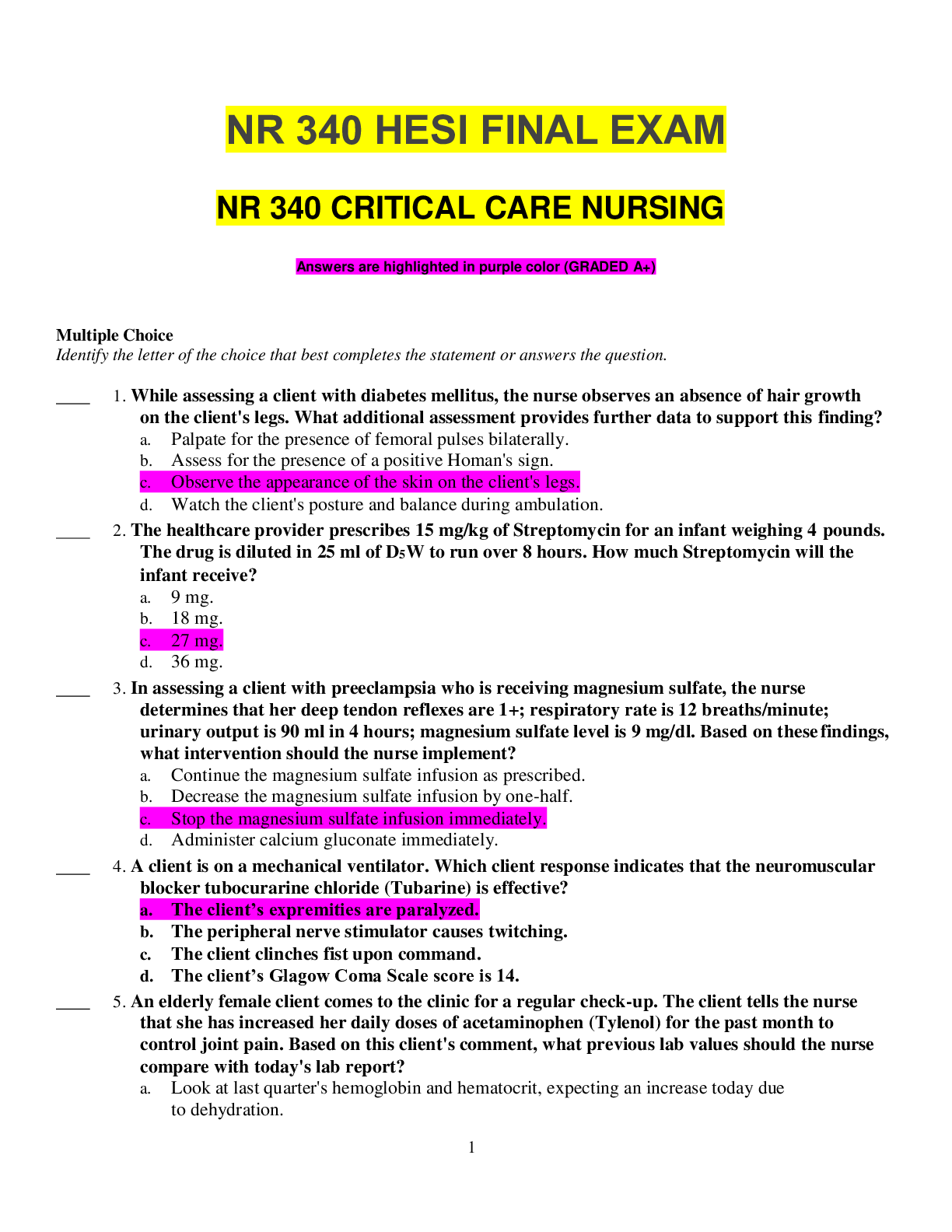
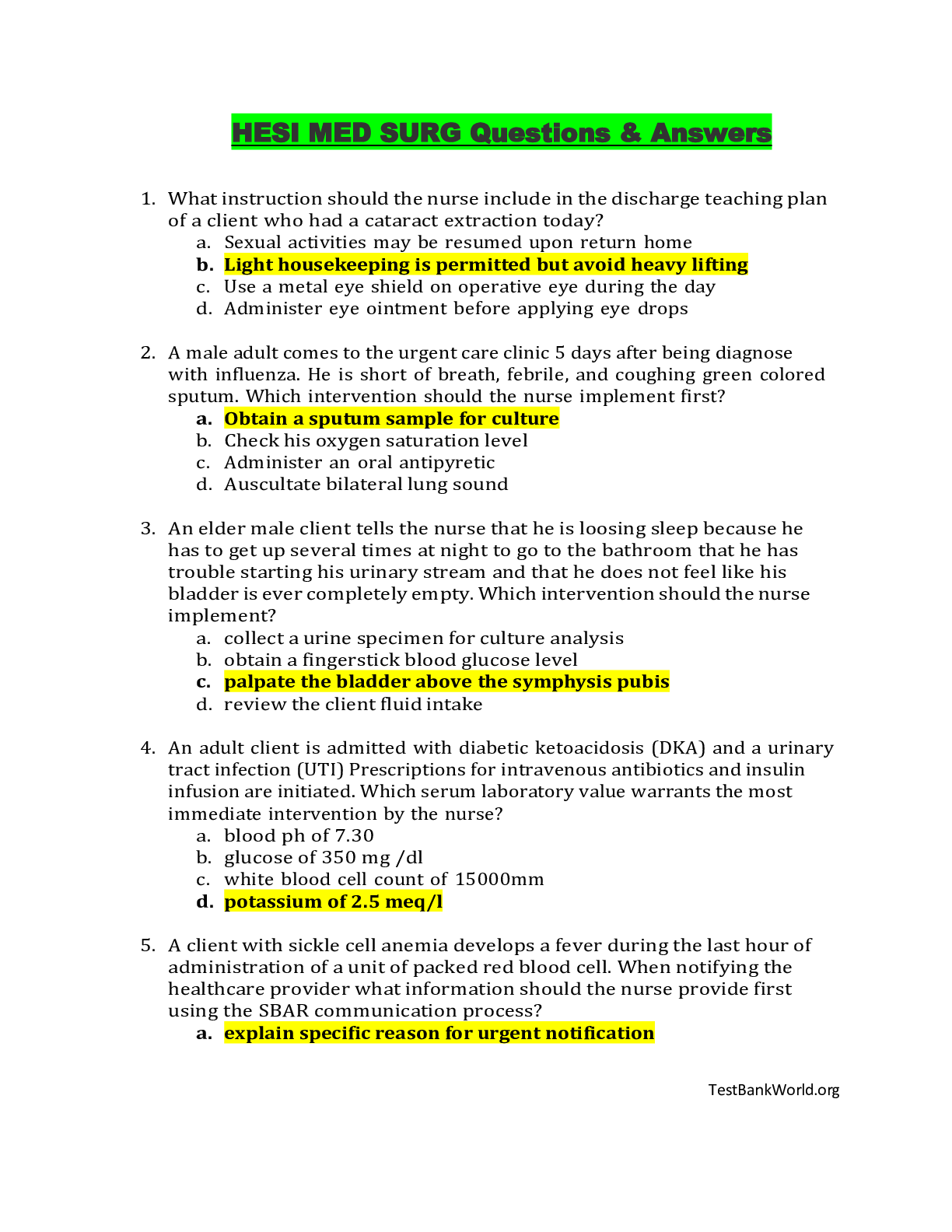
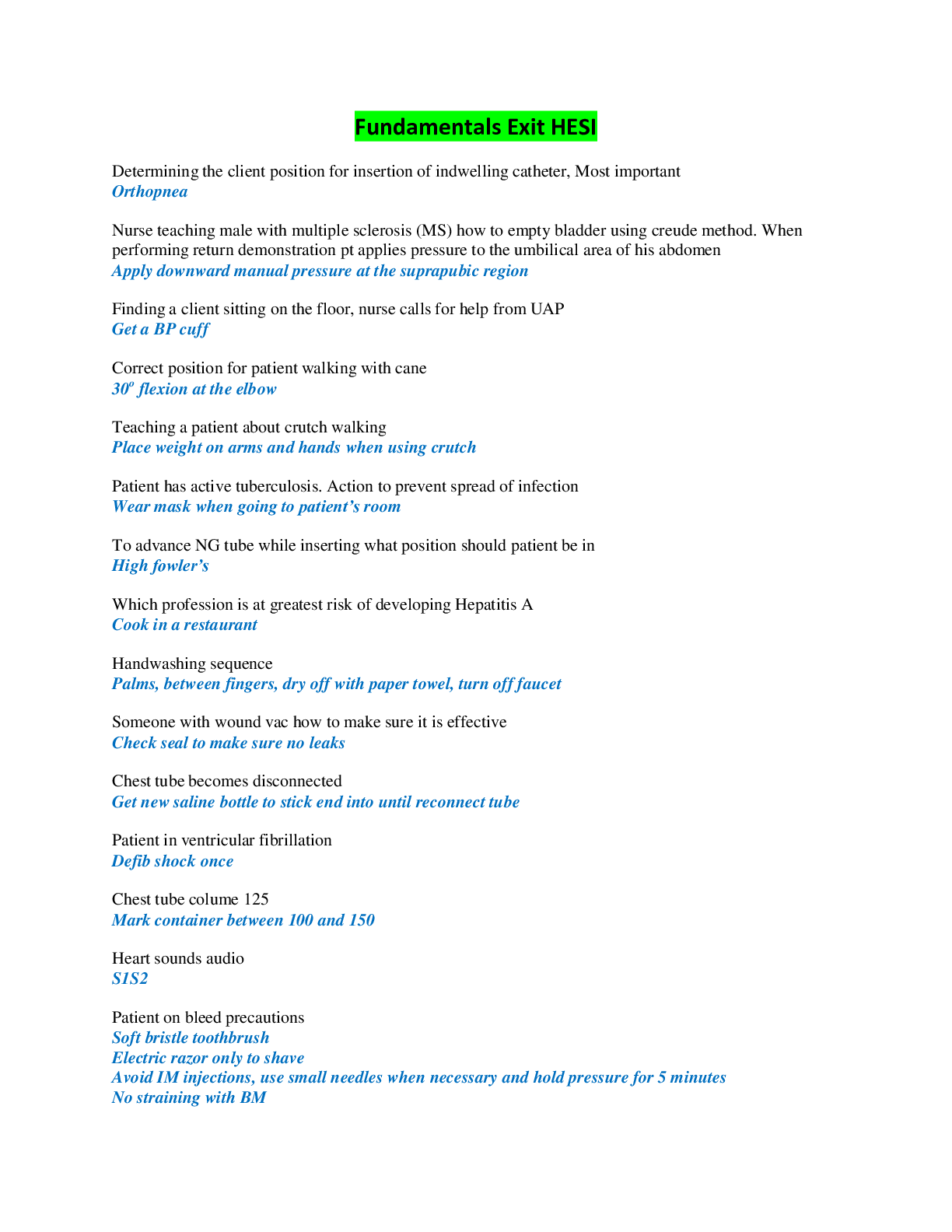
.png)
.png)
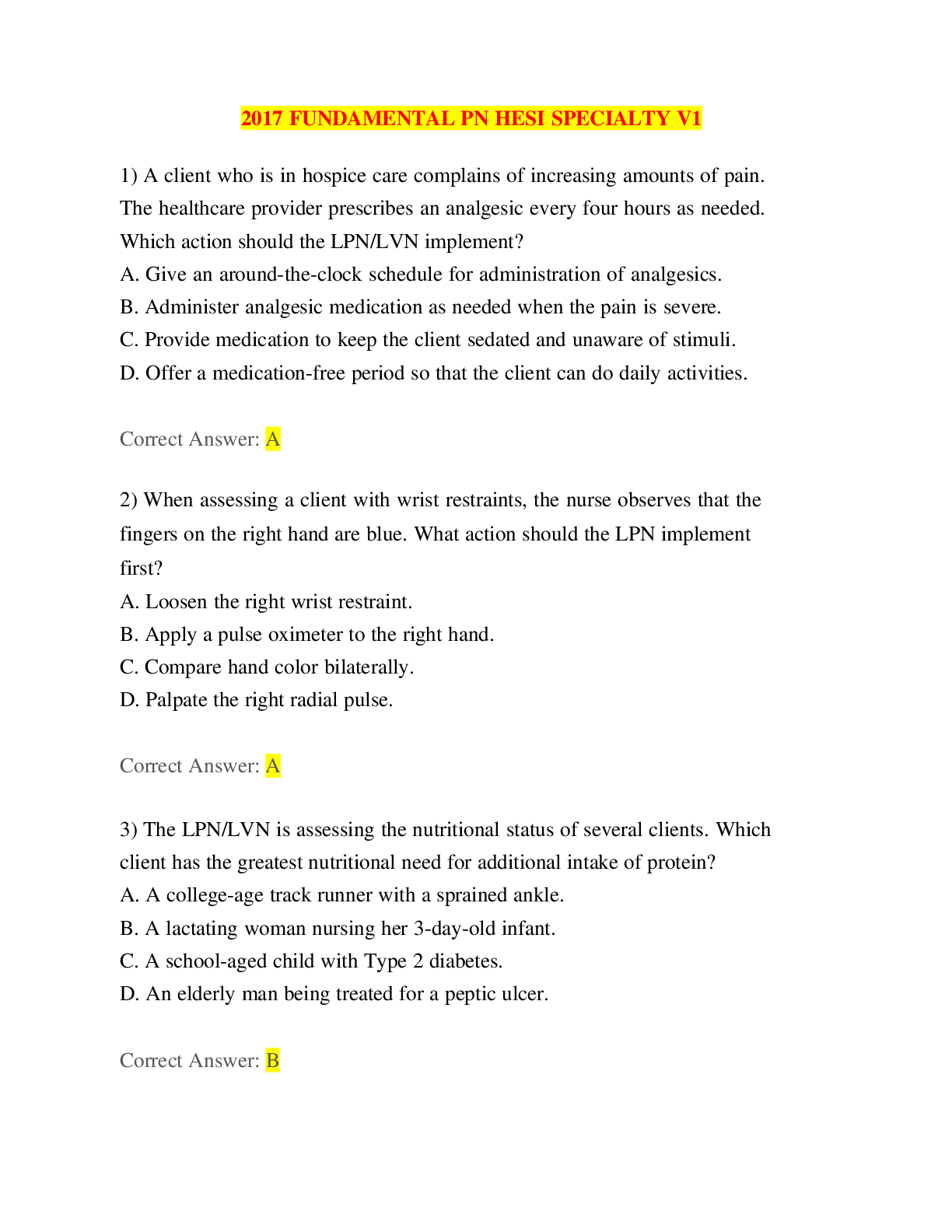
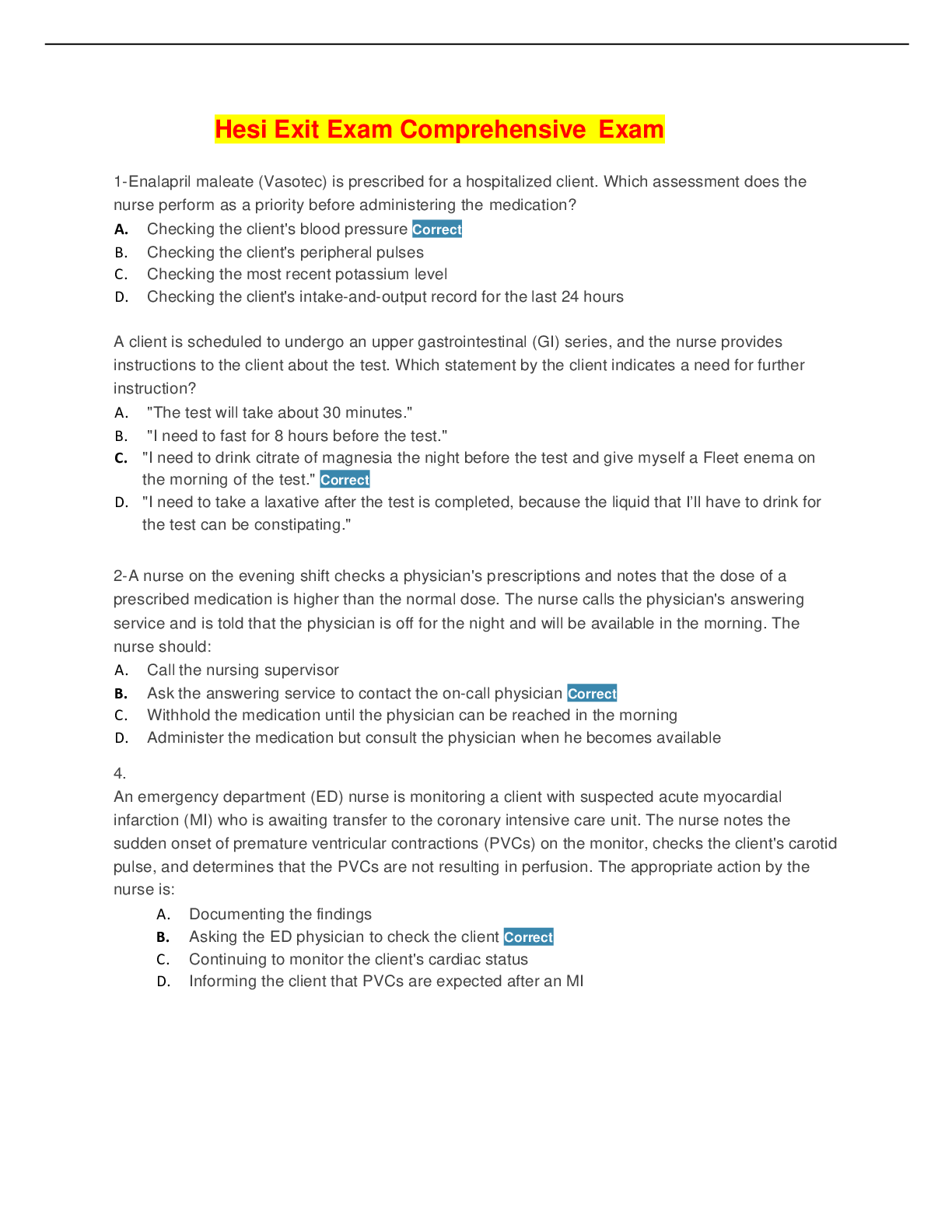
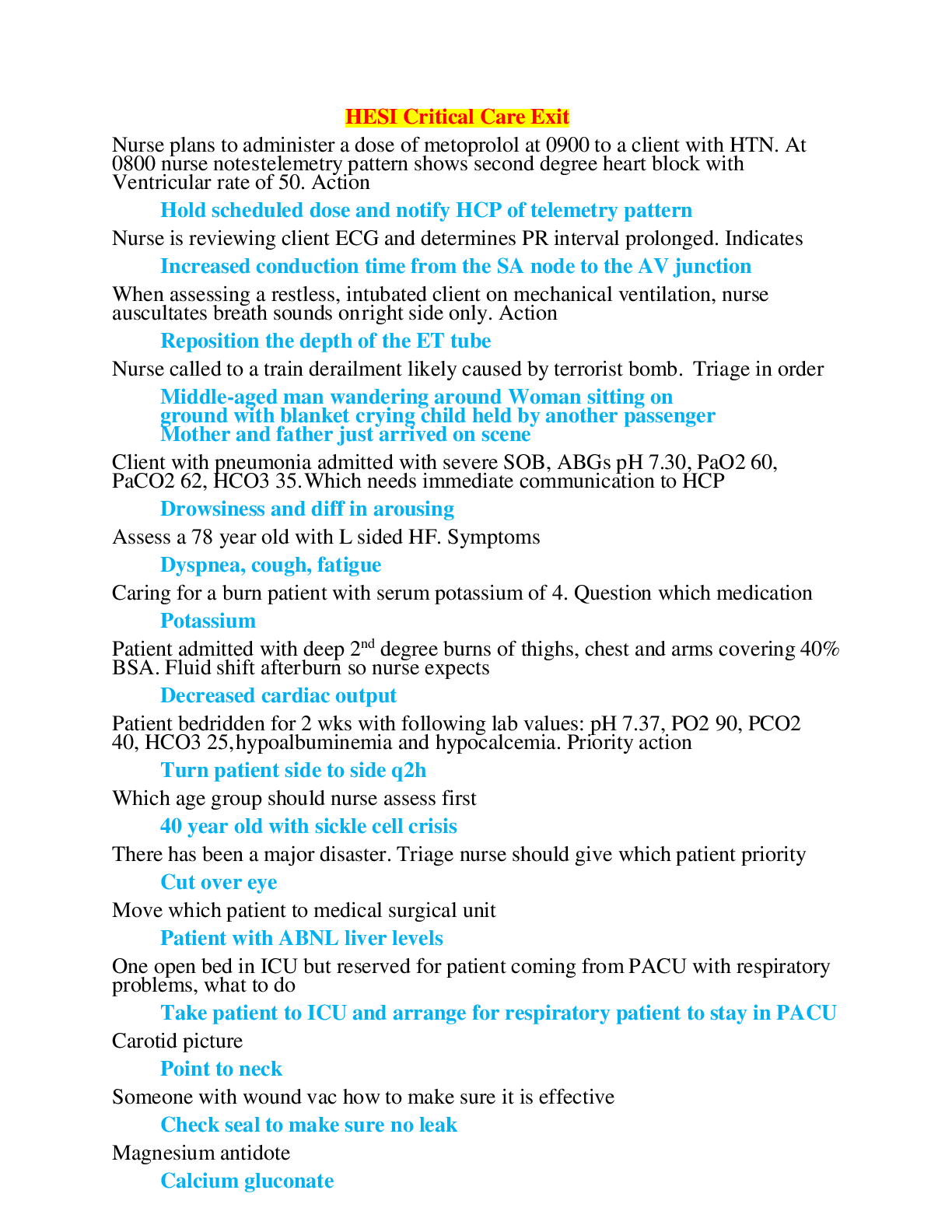
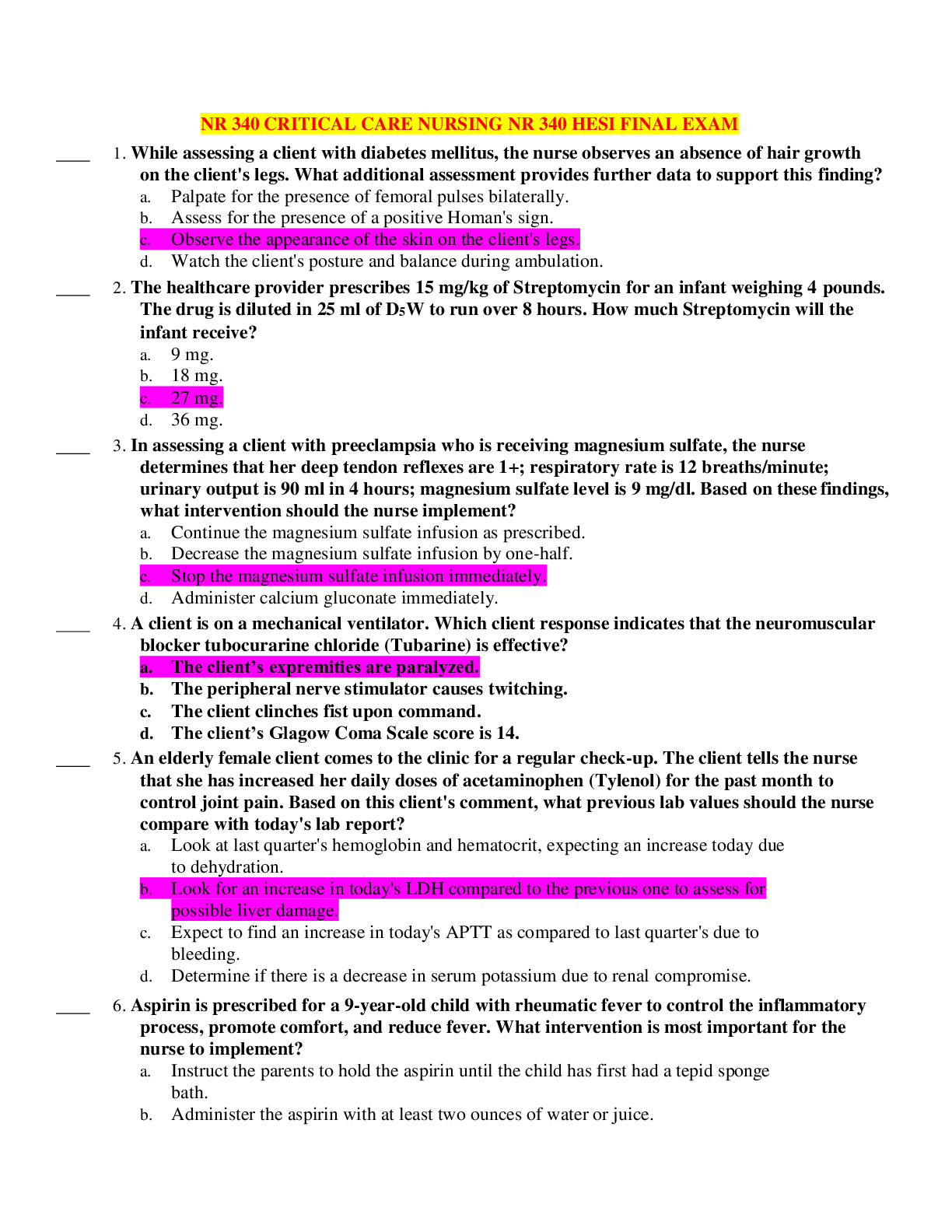
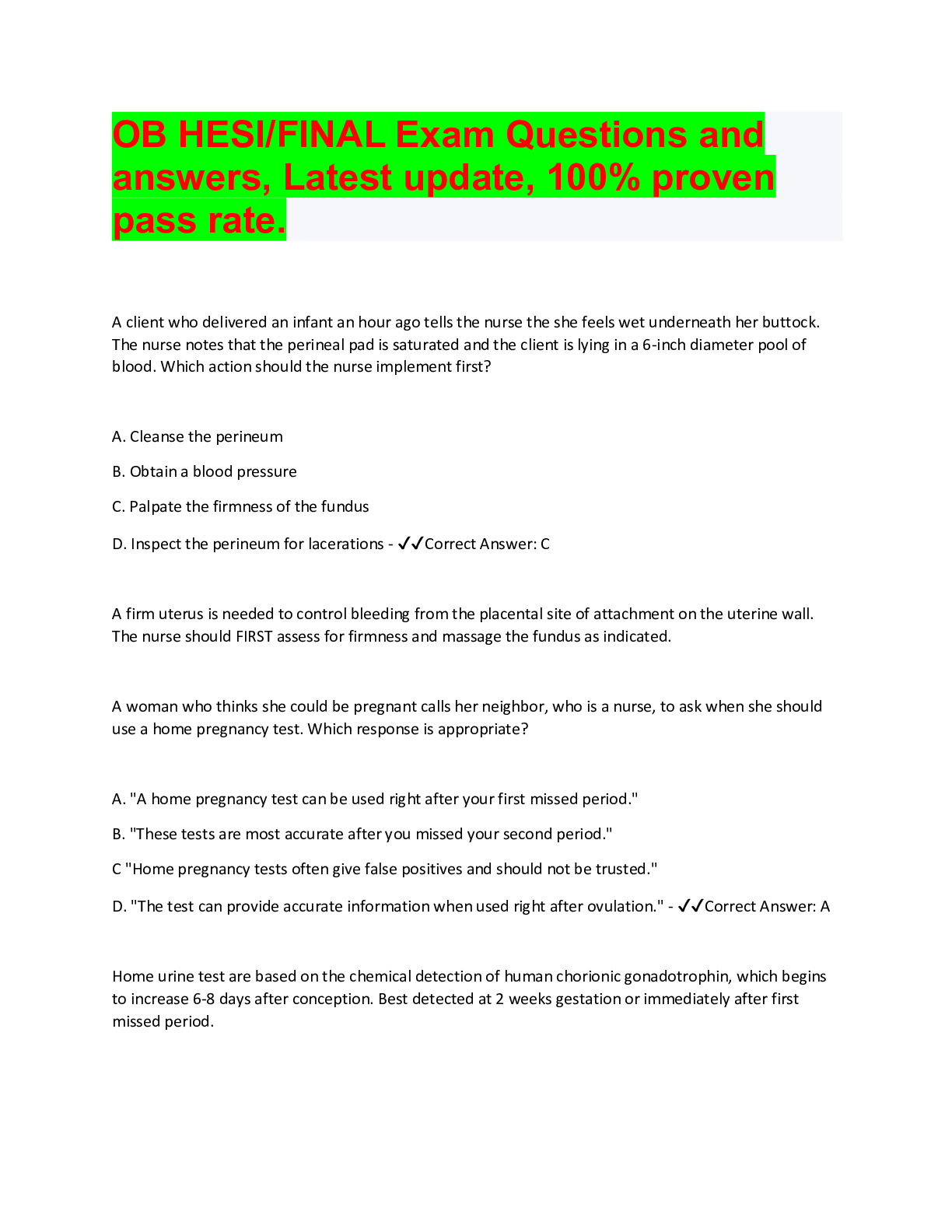
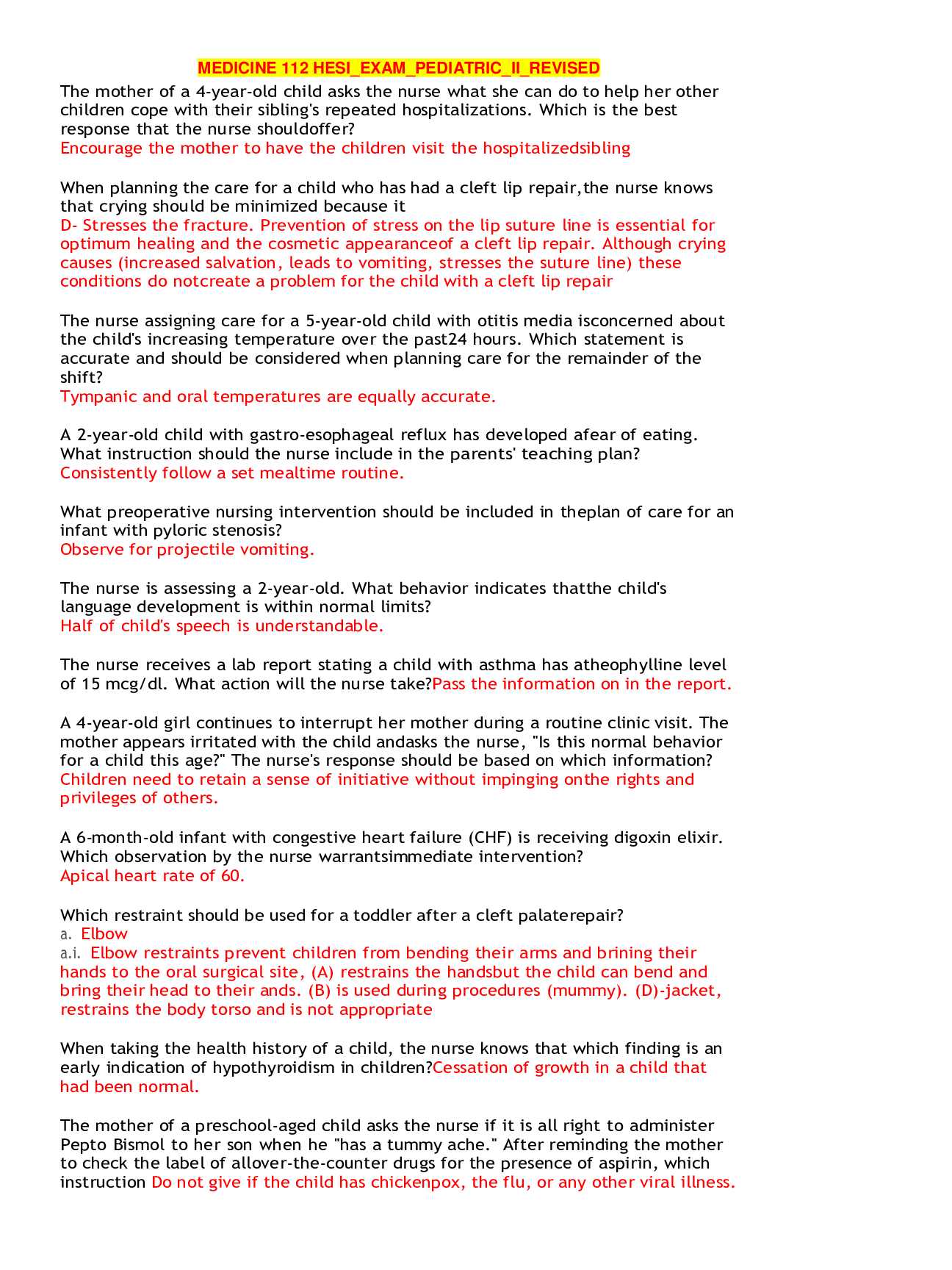

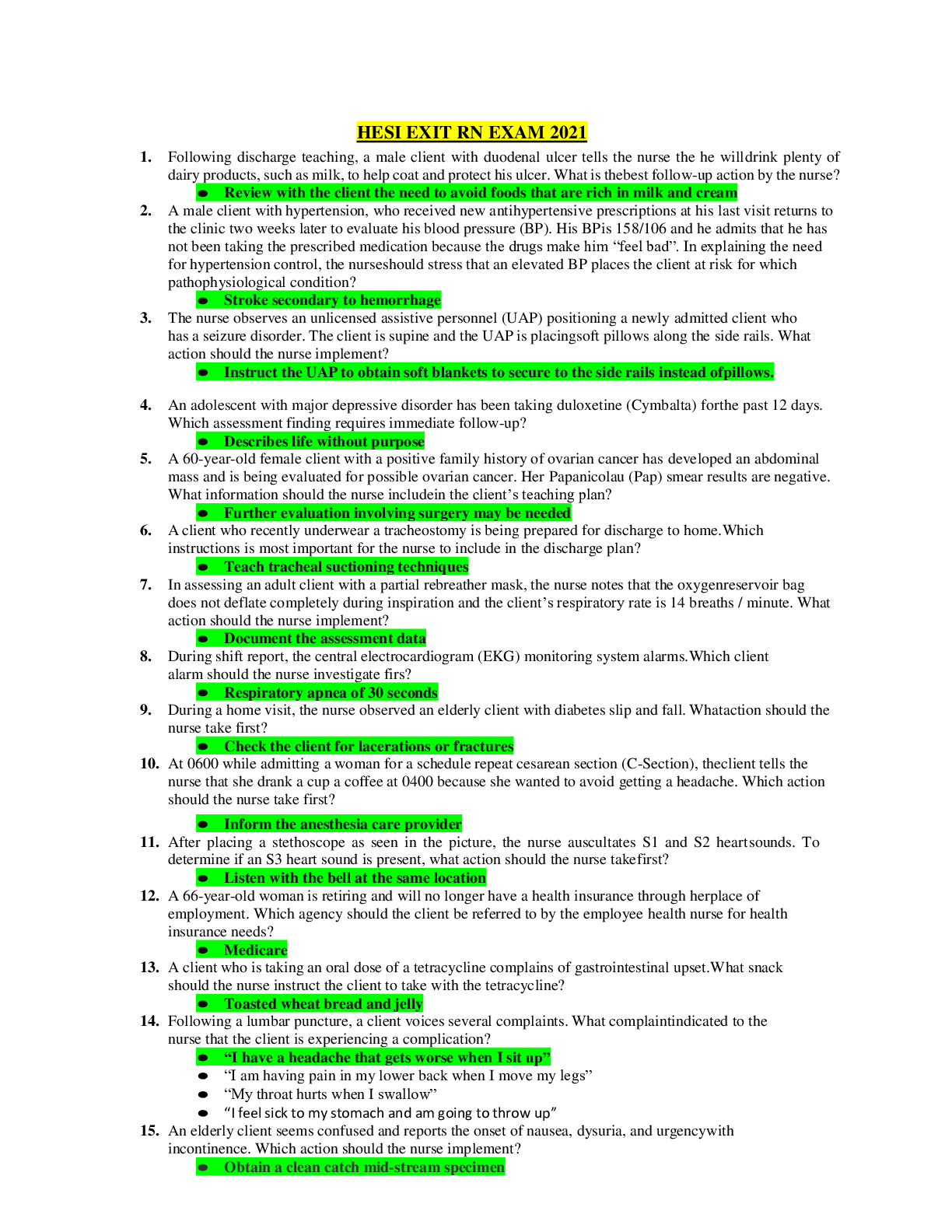
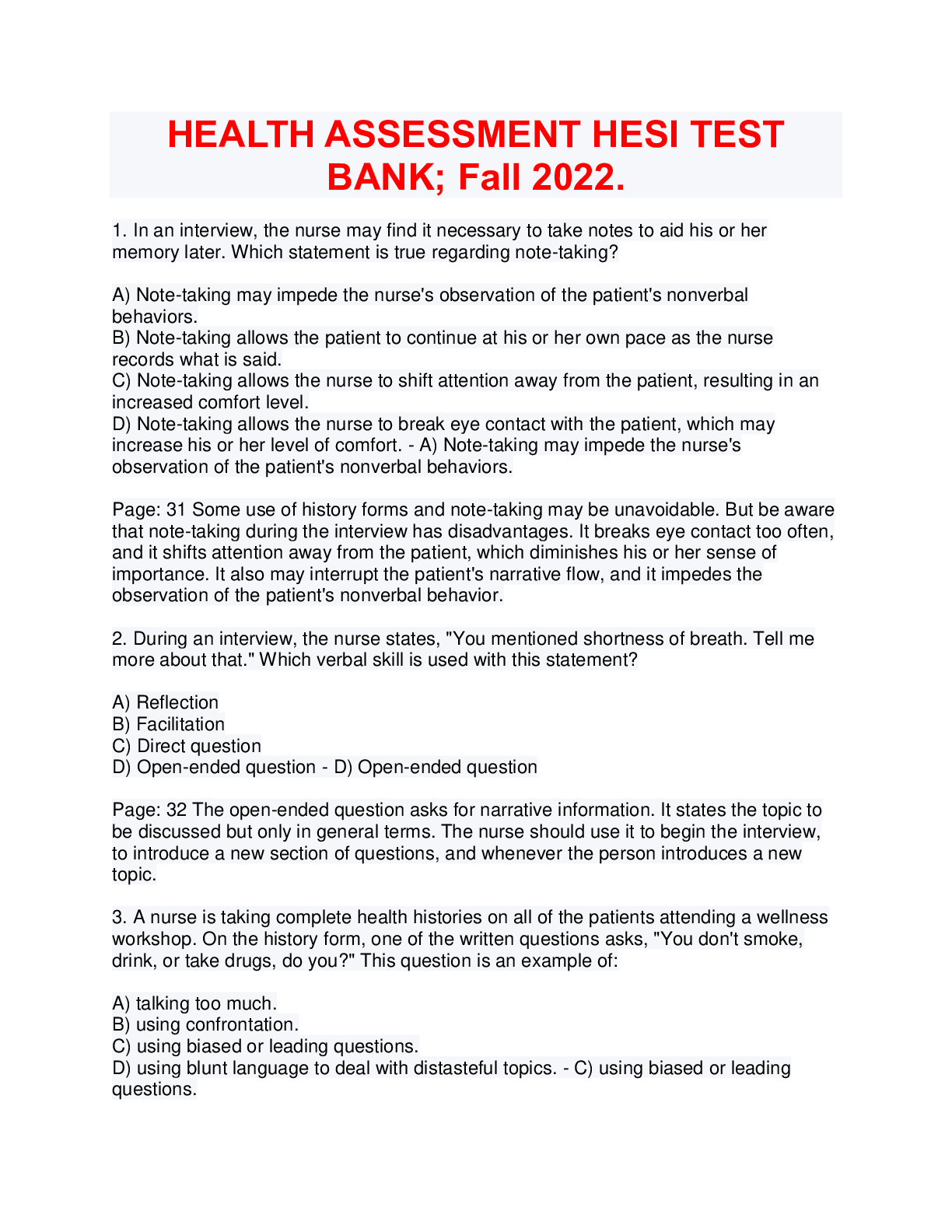
 Practice Test 2022.png)


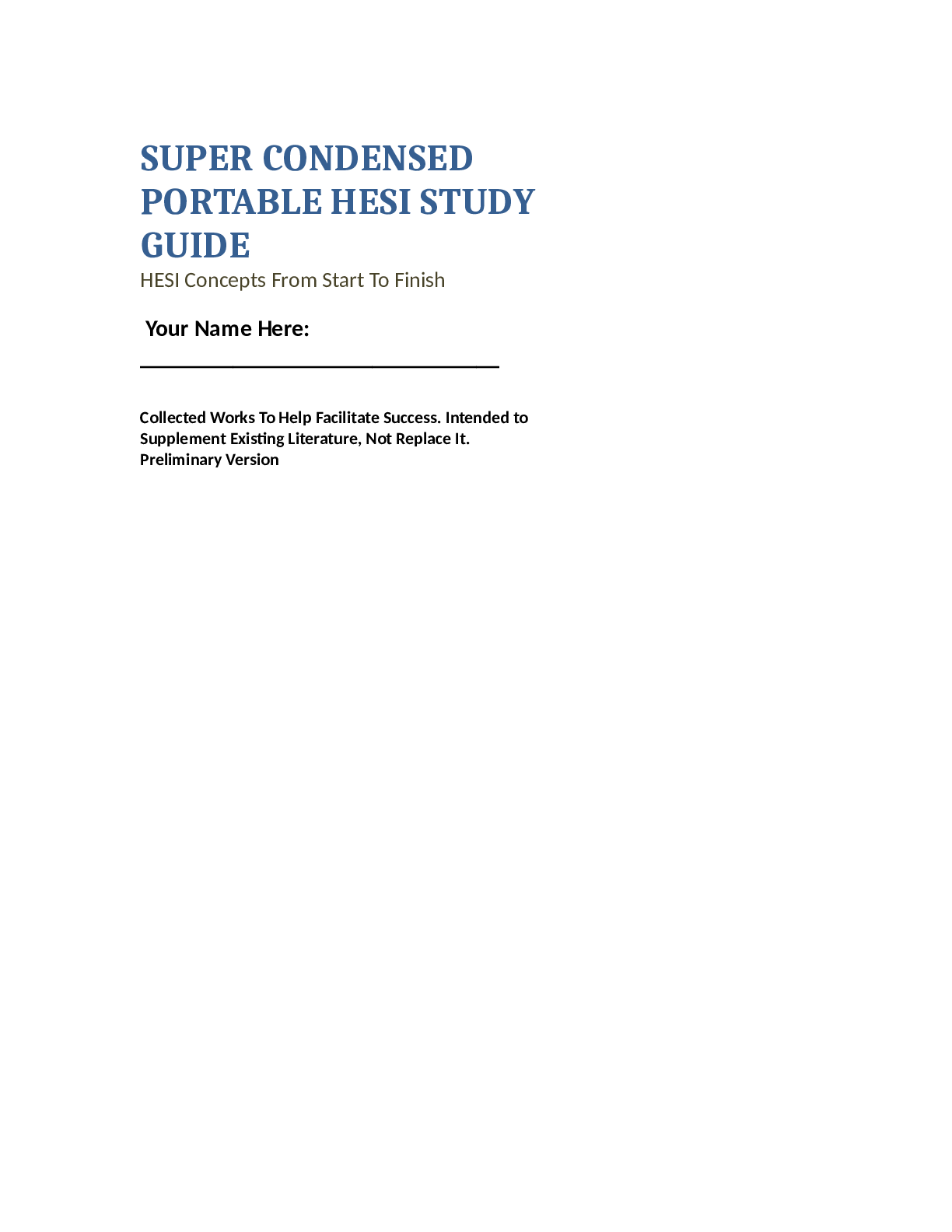




 (1).png)



